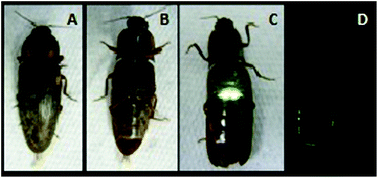Luciferase from Fulgeochlizus bruchi (Coleoptera:Elateridae), a Brazilian click-beetle with a single abdominal lantern: molecular evolution, biological function and comparison with other click-beetle luciferases
Abstract
Bioluminescent click-beetles emit a wide range of bioluminescence colors (λMax = 534–594 nm) from thoracic and abdominal lanterns, which are used for courtship. Only the luciferases from Pyrophorus and Pyrearinus species were cloned and sequenced. The Brazilian Fulgeochlizus bruchi click-beetle, which inhabits the Central-west Cerrado (Savannas), is noteworthy because, differently from other click-beetles, the adult stage displays only a functional abdominal lantern, which produces a bright green bioluminescence for sexual attraction purposes, and lacks functional thoracic lanterns. We cloned the cDNA for the abdominal lantern luciferase of this species. Notably, the primary sequence of this luciferase showed slightly higher identity with the green emitting dorsal lantern luciferases of the Pyrophorus genus instead of the abdominal lanterns luciferases. This luciferase displays a blue-shifted spectrum (λMax = 540 nm), which is pH-insensitive from pH 7.5 to 9.5 and undergoes a slight red shift and broadening above this pH; the lowest KM for luciferin among studied click-beetle luciferases, and the highest optimum pH (9.0) ever reported for a beetle luciferase. At pH 9.0, the KM for luciferin increases, showing a decrease of affinity for this substrate, despite the higher activity. The slow luminescence decay rate of F. bruchi luciferase in vitro reaction could be an adaptation of this luciferase for the long and sustained in vivo luminescence display of the click-beetle during the courtship, and could be useful for in vivo intracellular imaging.


 Please wait while we load your content...
Please wait while we load your content...